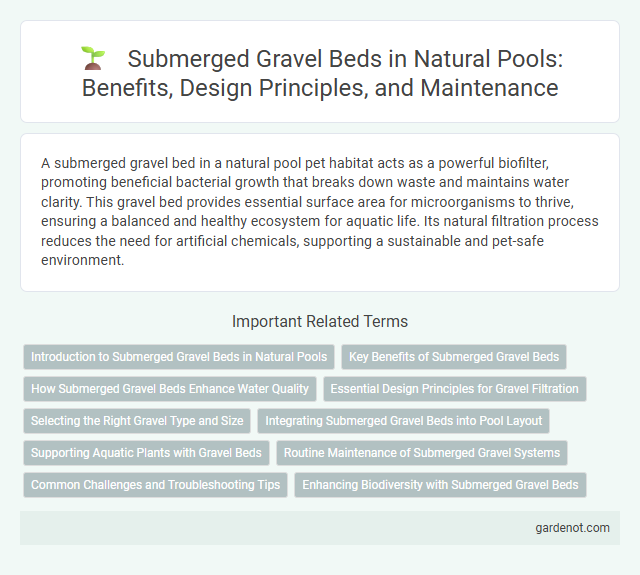A submerged gravel bed in a natural pool pet habitat acts as a powerful biofilter, promoting beneficial bacterial growth that breaks down waste and maintains water clarity. This gravel bed provides essential surface area for microorganisms to thrive, ensuring a balanced and healthy ecosystem for aquatic life. Its natural filtration process reduces the need for artificial chemicals, supporting a sustainable and pet-safe environment.
Introduction to Submerged Gravel Beds in Natural Pools
Submerged gravel beds in natural pools serve as essential biological filters by creating a habitat for beneficial microorganisms that break down organic matter and pollutants. These gravel layers support the natural purification process, enhancing water clarity and quality without chemical additives. Optimizing gravel size and distribution ensures effective water flow and maximizes the filtration capacity in eco-friendly swimming environments.
Key Benefits of Submerged Gravel Beds
Submerged gravel beds in natural pools enhance water filtration by promoting beneficial microbial activity that breaks down organic matter and contaminants. These beds support a balanced aquatic ecosystem by providing habitat for microorganisms essential to maintaining water clarity and nutrient cycling. Their natural filtration capacity reduces the need for chemical treatments, contributing to sustainable and eco-friendly pool maintenance.
How Submerged Gravel Beds Enhance Water Quality
Submerged gravel beds act as natural biofilters by promoting beneficial microbial activity that decomposes organic matter and removes harmful pollutants from water. The porous structure of gravel provides an extensive surface area for biofilm development, facilitating nitrogen and phosphorus cycling essential for maintaining healthy aquatic ecosystems. This process significantly enhances water clarity and quality, supporting balanced and sustainable natural pools.
Essential Design Principles for Gravel Filtration
A submerged gravel bed in natural pool design serves as a critical filtration system by promoting biological filtration through its porous media, which supports beneficial bacteria that break down organic matter and contaminants. Optimal gravel size ranges between 2 to 8 millimeters, balancing effective water flow with sufficient surface area for microbial colonization, while the depth typically measures around 30 to 50 centimeters to ensure proper filtration capacity. Proper placement in the regeneration zone allows for sustained water purification, minimizing the need for mechanical filters and maintaining water clarity through natural processes.
Selecting the Right Gravel Type and Size
Choosing the right gravel type and size for a submerged gravel bed is crucial for maintaining efficient filtration and water clarity in a natural pool. Opt for rounded, medium to coarse gravel between 8 to 20 millimeters in diameter to promote optimal water flow while preventing clogging. Using inert, non-toxic materials like quartz or granite ensures long-term durability and supports beneficial microbial activity essential for natural purification processes.
Integrating Submerged Gravel Beds into Pool Layout
Integrating submerged gravel beds into natural pool layouts enhances water filtration by promoting microbial activity that breaks down contaminants. These gravel beds are strategically positioned along the pool's edge or shallow zones to maximize water circulation and oxygenation. Utilizing porous materials within the gravel bed supports beneficial bacteria, contributing to clearer, chemical-free water.
Supporting Aquatic Plants with Gravel Beds
Submerged gravel beds provide essential support for aquatic plants by offering a stable substrate for root anchorage and nutrient absorption. The porous structure of gravel facilitates water circulation, oxygenating the root zone and promoting healthy plant growth. This natural filtration system enhances water clarity and maintains balanced aquatic ecosystems in natural pools.
Routine Maintenance of Submerged Gravel Systems
Routine maintenance of submerged gravel bed systems in natural pools involves regular inspection and removal of accumulated debris and organic matter to prevent clogging and maintain water clarity. Ensuring proper water flow through the gravel is critical for effective biological filtration, which supports beneficial microbial activity essential for water purification. Periodic gravel agitation or vacuuming can enhance the system's performance by restoring permeability and preventing anaerobic conditions.
Common Challenges and Troubleshooting Tips
Submerged gravel beds in natural pools often face clogging issues caused by organic debris and fine sediments, which impede water flow and filtration efficiency. Regular maintenance includes backwashing or gentle agitation of the gravel to dislodge trapped particles, ensuring optimal water movement. Monitoring water quality parameters like pH and nutrient levels helps prevent algae growth and preserves the biological balance within the gravel bed system.
Enhancing Biodiversity with Submerged Gravel Beds
Submerged gravel beds in natural pools create diverse microhabitats that support various aquatic organisms, including beneficial bacteria, macroinvertebrates, and plant roots, enhancing overall biodiversity. These beds improve water filtration and provide essential spawning grounds for fish and amphibians, promoting a balanced ecosystem. By mimicking natural streambeds, submerged gravel beds sustain nutrient cycling and contribute to healthy, thriving aquatic environments.
Submerged gravel bed Infographic

 gardenot.com
gardenot.com